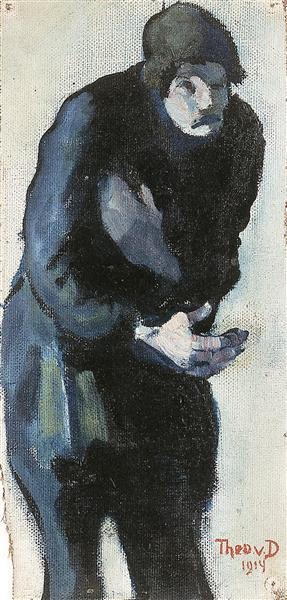Description
The work "Mendigo" (1914) by Theo Van Doesburg is a significant example of the intersection between modernity and social art, capturing an distressing sensation of alienation and hopelessness through its composition and color choice. Although the title of the work suggests a direct representation of poverty and marginalization, the interpretation is enriched when considering the style of Van Doesburg, a precursor to the STIJL movement.
At first glance, the painting It presents a central character that embodies the figure of the beggar, sitting in a position that evokes both vulnerability and resignation. The figure, with a dress that seems austere and somewhat worn, is trapped in an atmosphere of desolation. His face, although not excessively detailed, transmits an expression of sadness and helplessness, which invites spectators to reflect on the human condition and social disagreements. This representation is a call to awareness about social problems, an issue that Van Doesburg, along with other artists of his time, tried to address.
As for the composition, the use of geometric shapes and straight lines, characteristic of the neoplasticist style, offers an interesting contrast with the theme of pain and poverty. However, in this work, Van Doesburg moves away from excessive reduction and is allowed to explore a color palette that, although moderate, is loaded with meanings. The dark tones predominate, suggesting a gloomy environment, while color accents provide a dim light, almost like a lighthouse of hope in the midst of adversity. The use of color not only defines the figure of the beggar, but also establishes an atmosphere that throbs with emotions found.
The historical context in which this work is also is crucial. The work was painted in 1914, a year that represents the beginning of World War I, a period of great agitation and uncertainty in Europe. It is possible that the experience of war and its consequences on society influence Van Doesburg's vision, leading it to produce a work that is not only a visual representation, but also a critical comment on emerging social problems in its time.
While "beggar" is not one of the most recognized works in the wide corpus of Van Doesburg's work, it is a testimony of his ability to merge visual art with social narratives. Compared to other works of his contemporaneity, such as Piet Mondrian's works, which tend to focus on pure abstraction and harmony of forms, the beggar's approach is more figurative and political. This highlights the versatility and depth of thought present in the author's work, allowing it to submerge in the complexity of human existence with an approach that denounces the injustices of its environment.
In summary, "Mendigo" of Theo Van Doesburg is a work that transcends their appearance, inviting viewers to explore the social status and duality of suffering and hope. Through its composition, use of the color and emotional burden of its subject, Van Doesburg not only portrays material poverty, but also offers us a mirror in which to reflect on our own perceptions towards marginality and human dignity.
KUADROS ©, a famous paint on your wall.
Hand-made oil painting reproductions, with the quality of professional artists and the distinctive seal of KUADROS ©.
Art reproduction service with satisfaction guarantee. If you are not completely satisfied with the replica of your painting, we refund your money 100%.

